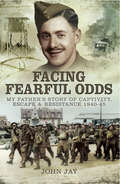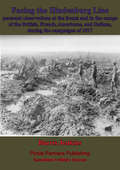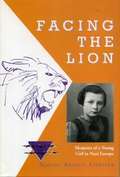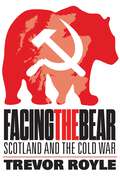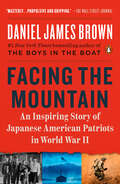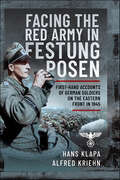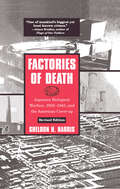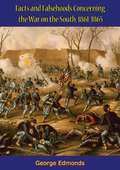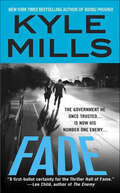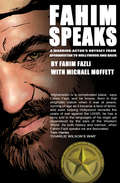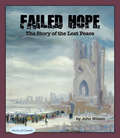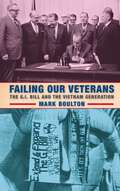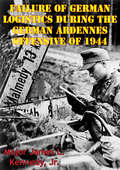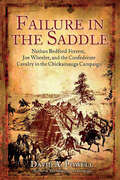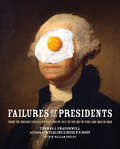- Table View
- List View
Facing Fearful Odds: My Father's Story of Captivity, Escape & Resistance 1940–1945
by John JayOn 22 May 1940 Alec Jay arrived in Calais with his Battalion, the Queen Victoria Rifles. After four days of intense fighting, he was taken prisoner of war along with those of his colleagues who were not killed. The Calais Garrison was not evacuated.His situation as a POW was exceptionally perilous as he was a Jew. Made to wear distinctive clothing, he was all too aware of the Nazis' determination to eradicate his race. Undeterred he made five escape attempts as well as leading a successful protest strike, one of the few during the War.When he finally escaped, he teamed up with Czech partisans and fought alongside them during the closing stages of the War.John Jay, a distinguished journalist and Investment manager, has reconstructed his Father's war using the archive material from four countries and numerous other sources and POW accounts. The result is a fascinating and inspiring story.
Facing The Hindenburg Line; Personal Observations At The Fronts: and in the camps of the British, French, Americans, and Italians, during the campaigns of 1917
by Burris JenkinsBurris A. Jenkins served in the double capacity of a war correspondent and a lecturer in the Y.M.C.A, he was sent to the European War in 1916/17. He travelled through many of the camps and rear-zones of the First World War, noting down anecdotes and sketches of the soldiers that he met; from the dashing French Chasseurs, to the stolid but humorous Tommies. He wrote of his experiences among the soldiers and the sights of the warzones on his return to the United States, part of the campaign to publicize the Allies sacrifices and gain support for the American entry into the War. Author -- Jenkins, Burris A., 1869-1945.Text taken, whole and complete, from the edition published in New York, F.H. Revell Co., 1917Original Page Count - 256 pages
Facing The Lion: Memoirs of a Young Girl in Nazi Europe
by Simone Arnold LiebsterFacing the Lion is the autobiographical account of a young girl's faith and courage. In the years immediately preceding World War II, Simone Arnold is a young girl who delights in life--her doting parents, her loving aunts and uncles, and her grandparents at their mountain farm in the Alsace-Lorraine region of France. As Simone grows into her preteen years, her parents turn from the Catholic Church and become devout Jehovah's Witnesses. Simone, too, embraces the faith. The Nazi party (the "Lion") takes over Alsace-Lorraine, and Simone's schools become Nazi propaganda machines. Simone refuses to accept the Nazi party as being above God. Her simple acts of defiance lead her to be persecuted by the school staff and local officials, and ignored by friends. With her father already taken away to a German concentration camp, Simone is wrested away from her mother and sent to a reform school to be "reeducated." There, Simone learns that her mother has also been put in a camp. Simone remains in the harsh reform school until the end of the war. She emerges feeling detached from life, but the faith that sustains her through her ordeals helps her rebuild her world. Facing the Lion provides an interesting and detailed view of ordinary country and town life in the pre-war years and during Hitler's regime. This inspiring story of a young girl standing up for her beliefs in the face of society's overwhelming pressure to conform is a potent reminder of the power of remaining true to one's beliefs. "...a shining example for the power of the spirit to triumph over evil....an eloquent firsthand account of a little girl's struggle to keep her faith in a world which had gone mad." --Ernst Rodin, author, War & Mayhem: Reflections of a Viennese Physician
Facing the Bear: Scotland and the Cold War
by Trevor RoyleThe author of Culloden explores Scotland&’s history during the Cold War. Between the end of the Second World War and the collapse of Communism, confrontation with the Soviet Union was an everyday reality. As part of NATO&’s response, Scotland played a key role in the alliance&’s forward maritime defense strategy, aimed at containing the Soviet threat from naval and air forces. During this period, 10 percent of the UK&’s naval and air forces were based in Scotland, and there was a substantial U.S. presence, as well as top secret satellite and command stations. In Facing the Bear, Trevor Royle paints a fascinating portrait of this extraordinary period, examining not just the wider military and political contexts, but also showing how the defense industry brought huge economic benefits, how CND maintained a high-profile presence, and how anti-nuclear sentiments underpinned much of the left&’s thinking in Scotland and contributed to the hegemony enjoyed by the Labour Party in Scotland during the Cold War.Praise for Facing the Bear&“Engrossing . . . . Like a military commander at the top of his game, Royle marshals his material to maximum effect to show how Scotland has been shaped by, and also helped shape, the Cold War . . . . He ranges far and wide and has that rare talent to marry the local with the geopolitical . . . . But this is not simply a story of military hardware and confrontation. Royle is very interesting on how the Cold War influenced our cultural life from the novel to poetry and the protest song.&” —Barclay McBain, The Herald (UK)
Facing the Mountain (Adapted for Young Readers): A True Story of Japanese American Heroes in World War II
by Daniel James BrownAdapted for young readers from the New York Times bestseller by Daniel James Brown, Facing the Mountain is the remarkable true story of three brave Japanese American soldiers who fought for the United States during World War II while facing discrimination at home. Perfect for readers of The Boys in the Boat.After the Japanese military bombed Pearl Harbor in 1941, Japanese Americans became the subject of racism and discrimination within the United States. Many were rounded up and put in concentration camps. But even while this was happening, there were many Japanese American soldiers who fought to ensure that all Americans were safe during the biggest conflict in world history.Facing the Mountain is the story of three Japanese American soldiers: Rudy Tokiwa, Fred Shiosaki, and Kats Miho, who volunteered for the 442nd Regimental Combat Team to fight for their country in World War II. The book covers the three soldiers' deployment to Europe and the struggles of their families back home. Woven throughout is the chronicle of Gordon Hirabayashi, one of a cadre of patriotic resisters who stood up against the government in defense of their own rights.Equal parts riveting war story, resisitance history, and courtroom drama, Facing the Mountain is a fascinating and impeccably researched book that will captivate young readers. Includes black and white photos and backmatter.
Facing the Mountain: An Inspiring Story of Japanese American Patriots in World War II
by Daniel James BrownA NEW YORK TIMES BESTSELLEROne of NPR's "Books We Love" of 2021Longlisted for the PEN/Jacqueline Bograd Weld Award for Biography Winner of the Christopher Award &“Masterly. An epic story of four Japanese-American families and their sons who volunteered for military service and displayed uncommon heroism… Propulsive and gripping, in part because of Mr. Brown&’s ability to make us care deeply about the fates of these individual soldiers...a page-turner.&” – Wall Street Journal From the #1 New York Times bestselling author of The Boys in the Boat, a gripping World War II saga of patriotism and resistance, focusing on four Japanese American men and their families, and the contributions and sacrifices that they made for the sake of the nation.In the days and months after Pearl Harbor, the lives of Japanese Americans across the continent and Hawaii were changed forever. In this unforgettable chronicle of war-time America and the battlefields of Europe, Daniel James Brown portrays the journey of Rudy Tokiwa, Fred Shiosaki, and Kats Miho, who volunteered for the 442nd Regimental Combat Team and were deployed to France, Germany, and Italy, where they were asked to do the near impossible. Brown also tells the story of these soldiers' parents, immigrants who were forced to submit to life in concentration camps on U.S. soil. Woven throughout is the chronicle of Gordon Hirabayashi, one of a cadre of patriotic resisters who stood up against their government in defense of their own rights. Whether fighting on battlefields or in courtrooms, these were Americans under unprecedented strain, doing what Americans do best—striving, resisting, pushing back, rising up, standing on principle, laying down their lives, and enduring.
Facing the Red Army in Festung Posen: First-Hand Accounts of German Soldiers on the Eastern Front in 1945
by Hans Klapa Alfred KriehnThe stories of two German soldiers who took part in the battles for Festung Posen (Poznań Fortress) in January and February 1945. Facing the Red Army in Festung Posen features the stories of two German soldiers who took part in the battles for Festung Posen (Poznań Fortress) in January and February 1945. Never before published in English, the accounts of Hans Klapa, written immediately after the war (1946) and Alfred Kriehn, a little later (early 1990s) provide details relating to the course of the battle, as well as the armaments of the German garrison, its morale and even first-hand descriptions of individual actions during bloody street fighting. Although describing the same battle, both memoirs are completely different as they represent different branches of the armed forces and each takes place in different parts of the city. While Hans Klapa fought only in the eastern part, Alfred Kriehn describes the fighting on the western side. However, what separates the two accounts the most is the fate of both heroes immediately after the battle, with Klapa describing his epic, months-long struggle with his comrades not to fall into the hands of the enemy and to avoid being taken prisoner by the Soviets at any cost.
Factories of Death: Japanese Biological Warfare, 1932-45 and the American Cover-Up
by Sheldon H. HarrisFactories of Death details the activities of the Japanese army scientists that conducted numerous horrifying experiments upon live human beings. It investigates who from the upper echelons of the Japanese military and political establishments knew of the experiments, also the question of whether or not Allied POWs were subjected to such tests, and the nature of the deal that was brokered with US authorities after the war. This new edition has been completely updated, and contains an entirely new chapter detailing the numerous revelations that have surfaced since the book's initial publication in 1994.
Factors Affecting Joint Cooperation During The Civil War
by LCDR Timothy R. Hanley USNThis study is a historical analysis of selected joint Army Navy operations conducted along the East Coast during the American Civil War. It begins with a description of the ante-bellum conditions of the Army and Navy and the organizational structure of the War and Navy Departments. Three joint operations are analyzed; the Fort Sumter Relief Expedition of 1861, the Port Royal Expedition of 1862, and the Charleston Campaign of 1863.In none of the joint operations covered by this study was there a unified command structure between the Army and Navy. Mutual support between the services was dependent upon voluntary cooperation between the respective service commanders.This study determines what factors influenced the degree of cooperation between the service commanders of joint operations during the Civil War. Many of the factors which either facilitated or hindered joint cooperation during that time could affect contemporary joint operations, particularly in the early stages before a unified command structure is established. An appreciation of those factors is both helpful in understanding the outcome of Civil War joint operations as well as providing some insight into the problems faced by contemporary commanders in a joint environment.
Facts and Falsehoods Concerning the War on the South, 1861-1865
by George EdmondsElizabeth Avery Meriwether was the author of many books, giving accurate and vivid descriptions of historical incidents of importance in the South. Her plots were widely regarded as skillfully conceived and developed, told with remarkable vigor, and true pictures of conditions that were passing away, making her books important additions to the literature of old Southern life.“Facts and Falsehoods Concerning the War of the South of 1861 and 1865,” which she wrote under the pen name George Edmonds and first published in 1904, was considered by Meriwether herself to be the most valuable book that she ever wrote or could write, because in it she told the truth about historical events:“This little work is offered. It does not aspire to the dignity of History. It is mostly a collection of facts under one cover, which I trust will prove of use to the future historians of the South. Perhaps the fittest title to this work would be “A Protest Against Injustice”—the injustice of misrepresentation—of false charges—of lies. The feeling of injustice certainly inspired the idea of this work. The greater number of the facts herein laid before the reader were not drawn from Southern or Democratic sources, but from high Republican authorities. Part first of this work presents Abraham Lincoln to the people of this generation as his contemporaries saw and knew him. The characteristics portrayed will be a revelation to many readers.”
Fade: A Thriller (Fade Ser. #1)
by Kyle MillsNew York Times bestselling author of Vince Flynn's Mitch Rapp novels Kyle Mills rewrites the rules for thrillers with Fade -- a novel ripped from today's headlinesWelcome to the new war on terror. A secret wing of Homeland Security is recruiting agents to work undercover in the Middle East, and the director wants his second-in-command, Matt Egan, to bring aboard an old friend, Salam Al Fayed—better known as Fade. He's perfect: An ex-Navy Seal and the son of immigrants, he speaks flawless Arabic. Trouble is, he's "retired"; he was wounded in the line of duty, and the government refused to pay for the risky surgery that could have helped him. Now he's walking around with a bullet lodged near his spine, and he's not too fond of anyone in the government -- least of all, his ex-best friend Matt Egan, whom he blames for his present condition. Against Egan's wishes, the director tries to "persuade" Fade to join the team. But Fade is prepared to fight back at any cost. The chase is on -- will Matt be able to find his friend-turned-fugitive before Fade can take the ultimate revenge? Fade is a remarkable, take-no-prisoners program from an unparalleled writer at the height of his talents.
Faded Coat of Blue (A Novel of the Civil War)
by Ralph PetersThe first Major Abel Jones Civil War mystery. &“Immensely rewarding . . . irresistibly readable . . . finely wrought . . . a genuine novel of ideas.&” —The Washington PostWinner of the Herodotus Award In this winning blend of history and mystery, Owen Parry brings to life the story of Abel Jones, a Welsh immigrant and Union army officer. Jones finds himself mysteriously chosen as a confidential agent to General George McClellan. No stranger to the cruel paradoxes of war, he is asked to investigate the death of Anthony Fowler, a young volunteer captain shot through the heart. Set against the backdrop of battles and bordellos, of the intrigues of war-time Washington and the elegant mansions of old Philadelphia, Faded Coat of Blue paints a deeply moving portrait of the United States in the midst of our harshest trial. Fowler&’s murder is blamed on the Confederates, but whispers haunt the death of the fallen martyr, leading Abel Jones from the blood of the battlefield into a web of secrets and sinister relationships where evil and good intertwine . . . and where heroes fall prey to those who cherished them the most. &“A marvelous historical fiction work for Civil War buffs and for mystery lovers who simply appreciate a novel rich in language.&” —St. Louis Post-Dispatch&“Impeccably researched and energetically written . . . thoroughly believable . . . exciting, heartbreaking.&” —Chicago Tribune &“Jones&’s narrative voice is a feast of fine language . . . ingeniously authentic.&” —Publishers Weekly
Fahim Speaks
by Fahim Fazli Michael MoffettFahim Fazli is a man of two worlds: Afghanistan, the country of his birth, and America, the nation he adopted and learned to love. He's also a man who escaped oppression, found his dream profession, and then paid it forward by returning to Afghanistan as an interpreter with the US. Marines. When Fahim speaks, the story he tells is harrowing, fascinating, and inspiring. Born and raised in Kabul, Fahim saw his country and family torn apart by revolution and civil war. Dodging Afghan authorities and informers with his father and brother, Fahim made his way across the border to Pakistan and then to America. After reuniting with his mother, sisters, and one brother, he moved to California with dreams of an acting career. After fifteen turbulent years that included two unsuccessful arranged marriages to Afghan brides, he finally qualified for membership in the Screen Actors Guild--and found true American love. Though Fahim's California life was happy and rewarding, he kept thinking about the battlefields of Afghanistan. Haunted by a desire to serve his adopted country, he became a combat linguist. While other interpreters opted for safe assignments, Fahim chose one of the most dangerous: working with the Leathernecks in embattled Helmand Province, where his outgoing personality and deep cultural understanding made him a favorite of both marines and local Afghans--and a pariah to the Taliban, who put a price on his head. Fahim Speaks is an inspiring story of perseverance and patriotism--and of the special love that one man developed for his adopted country.
Failed Hope: The Story of the Lost Peace
by John Wilson2013 Information Book Awards — Long-listed Peace after the First World War inspires hope for a better life that’s crushed by the advent of the Second World War. Beginning with the Treaty of Versailles and the hope for the birth of a better world, Failed Hope follows the postwar rise of fascism, social unrest, Prohibition, the Great Depression, Adolf Hitler’s rise to power, and the wars in Abyssinia, Spain, and China. The general strike in Winnipeg provides a Canadian perspective to the global labour turmoil of the period. The book ends with the failure of appeasement and the outbreak of the Second World War. The information is presented in easily digestible segments, accompanied by photographs. Informative sidebars provide background information or connect world events to activities in Canada. Failed Hope links with John Wilson’s two previous books, Desperate Glory and Bitter Ashes, covering the history of the 20th century from 1914 to 1945 and the effects of its world wars.
Failed States: The Abuse of Power and the Assault on Democracy
by Noam ChomskyTHE WORLD'S FOREMOST CRITIC OF U.S. FOREIGN POLICY EXPOSES THE HOLLOW PROMISES OF DEMOCRACY IN U-S. ACTIONS ABRoAD -AND AT HOME THE UNITED STATES HAS REPEATEDLY asserted its right to intervene militarily against "failed states" around the globe. In this muchanticipated follow-up to his international bestseller Hegemony or Survival, Noam Chomsky turns the tables, showing how the United States itself shares features with other failed states and therefore is increasingly a danger to its own people and the world. Failed states, Chomsky writes, are those that are unable or unwilling "to protect their citizens from violence and perhaps even destruction" and "regard themselves as beyond the reach of domestic or international law." Though they may have democratic forms, Chomsky notes, failed states suffer from a serious "democratic deficit" that deprives their democratic institutions of real substance. Exploring the latest developments in U.S. foreign and domestic policy, Chomsky reveals Washington's plans to further militarize the planet greatly increasing the risks of nuclear war; assesses the dangerous consequences of the occupation of Iraq, which has fueled global outrage at the United States; documents Washington's self-exemption from international norms, including the UN Charter and the Geneva Conventions, the foundations of contemporary international law, and the Kyoto Protocol; and examines how the U.S. electoral system is designed to eliminate genuine political alternatives, impeding any meaningful democracy.
Failing Our Veterans: The G.I. Bill and the Vietnam Generation
by Mark BoultonReturning Vietnam veterans had every reason to expect that the government would take care of their readjustment needs in the same way it had done for veterans of both World War II and Korea. But the Vietnam generation soon discovered that their G.I. Bills fell well short of what many of them believed they had earned. Mark Boulton’s groundbreaking study provides the first analysis of the legislative debates surrounding the education benefits offered under the Vietnam-era G.I. Bills. Specifically, the book explores why legislators from both ends of the political spectrum failed to provide Vietnam veterans the same generous compensation offered to veterans of previous wars. Failing Our Veterans should be essential reading to scholars of the Vietnam War, political history, or of social policy. Contemporary lawmakers should heed its historical lessons on how we ought to treat our returning veterans. Indeed, veterans wishing to fully understand their own homecoming experience will find great interest in the book’s conclusions.
Failure In Independent Tactical Command: Napoleon’s Marshals In 1813
by Major John M. KeefeThis monograph offers a new perspective on an old subject. That is why did Napoleon's marshals, so successful in corps command, fail when given an independent army command? It examines in detail the defeats of Marshal Nicolas Charles Oudinot at Gross Beeren, Marshal Etienne MacDonald at Katzbach, and Marshal Michel Ney at Dennewitz.Many authors have speculated why these marshals failed in independent tactical command. They have offered such reasons as lack of talent, lack of guidance from Napoleon or the failure to understand the nature of Napoleonic warfare. While these reasons are valid, they are contributing factors rather than the primary reason for the failure of napoleon's marshals.A thorough analysis of Napoleon's Correspondences for the period 10 August through 8 September 1813 reveals that Napoleon did provide adequate guidance to his subordinate commanders. A detailed study of the actions of all three marshals in both movement to and conduct during battle reveals that they in fact understood the nature of Napoleonic warfare. Certainly lack of talent was not the problem as each had been very successful in combat for twenty-two years. The primary reason that these marshals failed was their inability to command and control their forces. Lack of adequate staffs and an inability to make the intellectual leap from corps to army command proved to be their downfall.
Failure Of British Strategy During The Southern Campaign Of The American Revolutionary War
by Major Jesse T. PearsonThis paper investigates the failure of British strategy during the southern campaign of the American Revolutionary War from 1780 to 1781. Following France's entry into the war in 1778, the British Secretary of State for the American Department, Lord George Germain, believed that Great Britain could expand the war into the south with minimal cost. This research traces Lord Germain's strategy from its origin in London in 1778 to its application in the American south by British Generals Henry Clinton and Charles Cornwallis during 1780 and 1781. It also analyzes crucial British engagements with the southern patriot army at the Battle of Cowpens in January 1781, the Battle of Guilford Courthouse in March 1781, and the final withdrawal of British forces from the southern interior following the Battle of Eutaw Springs in September 1781. This research identifies four factors that contributed to the failure of British strategy in the south: (1) a false British assumption of loyalist support among the populace, (2) British application of self-defeating political and military policies, (3) the British failure to deploy sufficient forces to control the territory, and (4) patriot General Nathanael Greene's campaign against British forces.
Failure Of German Logistics During The German Ardennes Offensive Of 1944
by Major James L. Kennedy Jr.This study investigates the role that logistics played in the failure of the German Offensive in the Ardennes in 1944. The thesis explains that despite the incredible build-up of forces and supplies, the inability of the German strategic and operational logistics systems to properly equip, fuel, arm, and move forces caused the failure of the Ardennes Offensive.The concept of this thesis starts with the overall strategic military and political situation of Germany in the fall of 1944 that Hitler used to base his decision to conduct the offensive in December 1944.The study then examines in detail the strategic capabilities during the build-up of supplies and the operational level organization and planning for the offensive. An analysis of the details on the impact of terrain, climate, allied air interdiction, and Operation Point Blank is included in this chapter.Then it examines the first weeks of the offensive and looks at the failure of the fuel and arm and move tactical logistics functions. An analysis of the impact of logistics on supporting operations is included in this chapter.
Failure in the Saddle: Nathan Bedford Forrest, Joe Wheeler, and the Confederate Cavalry in the Chickamauga Campaign
by David A. PowellWINNER, 2010, RICHARD HARWELL AWARD, GIVEN BY THE CIVIL WAR ROUND TABLE OF ATLANTA Confederate cavalry has a storied and favorable relationship with the history of the Civil War. Tales of raids and daring exploits create a whiff of lingering romance about the horse soldiers of the Lost Cause. Sometimes, however, romance obscures history. In August 1863 William Rosecrans’ Union Army of the Cumberland embarked on a campaign of maneuver to turn Braxton Bragg’s Army of Tennessee out of Chattanooga, one of the most important industrial and logistical centers of the Confederacy. Despite the presence of two Southern cavalry corps (nearly 14,000 horsemen) under legendary commanders Nathan Bedford Forrest and Joe Wheeler, Union troops crossed the Tennessee River unopposed and unseen, slipped through the passes cutting across the knife-ridged mountains, moved into the narrow valleys, and turned Bragg’s left flank. Threatened with the loss of the railroad that fed his army, Bragg had no choice but to retreat. He lost Chattanooga without a fight. After two more weeks of maneuvering, skirmishing, and botched attacks Bragg struck back at Chickamauga, where he was once again surprised by the position of the Union army and the manner in which the fighting unfolded. Although the combat ended with a stunning Southern victory, Federal counterblows that November reversed all that had been so dearly purchased. David A. Powell’s Failure in the Saddle: Nathan Bedford Forrest, Joseph Wheeler, and the Confederate Cavalry in the Chickamauga Campaign is the first in-depth attempt to determine what role the Confederate cavalry played in both the loss of Chattanooga and the staggering number of miscues that followed up to, through, and beyond Chickamauga. Powell draws upon an array of primary accounts and his intimate knowledge of the battlefield to reach several startling conclusions: Bragg’s experienced cavalry generals routinely fed him misleading information, failed to screen important passes and river crossings, allowed petty command politics to routinely influence their decision-making, and on more than one occasion disobeyed specific and repeated orders that may have changed the course of the campaign. Richly detailed and elegantly written, Failure in the Saddle offers new perspectives on the role of the Rebel horsemen in every combat large and small waged during this long and bloody campaign and, by default, a fresh assessment of the generalship of Braxton Bragg. This judiciously reasoned account includes a guided tour of the cavalry operations, several appendices of important information, and original cartography. It is essential reading for students of the Western Theater. About the Author: David A. Powell is a graduate of the Virginia Military Institute (Class of 1983) with a BA in history. He has published numerous articles in magazines, more than fifteen historical simulations of various battles, and is the co-author (with David A. Friedrichs) of The Maps of Chickamauga: An Atlas of the Chickamauga Campaign, Including the Tullahoma Operations, June 22–September 23, 1863, a selection of the History and Military book clubs.
Failure of a Mission: Berlin, 1937-1939
by Nevile HendersonTHIS UNIQUE PERSONAL NARRATIVE REVEALS FOR THE FIRST TIME IN DRAMATIC DETAILS THE ENTIRE STORY OF THE COMING OF THE SECOND WORLD WARThe thousands of Americans who read the spirited account of Sir Nevile Henderson’s conversation with Ribbentrop in the fateful hours before the German invasion of Poland will realize the importance and guess at the interest of this book. Henderson, a British diplomat of long experience and proven character, was ambassador for his country in Berlin from 1937 to 1939. This is the story of his attempt, and his failure, to avert the calamity of European war…“Sir Nevile Henderson’s book is the first personal memoir we have had of the beginnings of the second world war. This would in itself ensure its importance. But quite aside from this it is a book of exceptional quality. It tells things that very few other people in the world could tell with such detachment. Henderson describes in detail his allegedly ‘pro-German’ course at the beginning, and then his swiftly rising disillusion, until—step by excruciating step—the grisly business was complete. It is not an indiscreet book—no one of the type of Sir Nevile Henderson could ever be more than mildly indiscreet—but there are sidelights on the Nazi leaders of the utmost value. I read these pages with complete fascination. They are indispensable to the student of the contemporary world tragedy.”—JOHN GUNTHER, Authority on World Affairs“Upon his recollections of those last stirring days of peace historians will base much.”—THE NEW YORK HERALD TRIBUNE“Failure of a Mission reveals the failure of diplomacy when faced by brute force….Here is history itself recorded by one of its helpless human instruments. It is not often that a diplomat records his failure with such engaging frankness. This is the first source book on the second World War. It will remain one of the most important.”—H. V. KALTENBORN, Radio News Commentator
Failures of the Presidents: From the Whiskey Rebellion and War of 1812 to the Bay of Pigs and War in Iraq
by M. William Phelps Thomas J. CraughwellTake a humbling journey through America’s proud history with this engaging and informative look at the nation’s most epic presidential blunders.Failures of the Presidents recounts twenty of the worst bad calls to come out of the executive office, ranging from the nation’s birth to the start of the twenty-first century. Author Thomas Craughwell begins with George Washington, who tried to pay for the Revolutionary War with a tax on whiskey—a choice that sparked the newly formed country’s first bloody rebellion.Centuries later, another George—the second President Bush—was convinced that Iraq was hiding weapons of mass destruction. His invasion of the country resulted in a protracted, deadly, and costly war that gave a serious blow to American credibility around the world.Between these episodes, there were many other regrettable, embarrassing, or downright disastrous mistakes made by residents of the White House—the worst of which are explored in this book.
Fair Stood the Wind to France
by H. E. BatesFair Stood the Wind for France, first published in 1944, is author H. E. Bates' fictional account of a downed English bomber-pilot and his crew over occupied France during World War II. The men are taken in by a French family who hide them in their home. However, the pilot, injured during the plane's landing, must remain in France to heal, while his crew begin their journey back to friendly territory. The pilot falls in love with the home-owner's daughter, their relationship grows and eventually they travel together across France, seeking a way back to England.Fair Stood the Wind for France rises above the average romance, however. Set against the horrors of war, it takes on a life-affirming force, enhanced by the simple, yet elegant prose of the author. Bates also excels at evoking a sense of place; much of the story occurs over the course of a hot summer in rural France, and there are many beautiful descriptions of the French countryside as it bakes in the summer heat. In 1980, the book was the subject of a 4-part television mini-series by the BBC.
Fairbairn-Sykes Commando Dagger
by Howard Gerrard Leroy ThompsonThe Fairbairn-Sykes Commando dagger has become iconic as the most widely recognized fighting knife in the world. The origins of the dagger can be traced to Shanghai in the 1930s where W. E. Fairbairn and US Marine officers including Sam Yeaton carried out experiments in developing what they considered the perfect knife for close combat. When Fairbairn and Sykes became instructors for the Commandos, they refined the design which would evolve into the classic Fairbairn-Sykes dagger. The dagger was first used during early Commando raids into occupied Europe but saw action in every theatre of World War II (1939-1945). US Rangers and Marines who had trained with the Commandos took their Fairbairn-Sykes daggers home which also influenced the development of American Special Forces daggers. The Fairbairn-Sykes remained in use with many units after the war, and has become a symbol of commando and special forces units throughout the world.From the Trade Paperback edition.
Fairbairn-Sykes Commando Dagger
by Leroy ThompsonThe Fairbairn-Sykes Commando dagger has become iconic as the most widely recognized fighting knife in the world. The origins of the dagger can be traced to Shanghai in the 1930s where W. E. Fairbairn and US Marine officers including Sam Yeaton carried out experiments in developing what they considered the perfect knife for close combat. When Fairbairn and Sykes became instructors for the Commandos, they refined the design which would evolve into the classic Fairbairn-Sykes dagger. The dagger was first used during early Commando raids into occupied Europe but saw action in every theatre of World War II. US Rangers and Marines who had trained with the Commandos took their Fairbairn-Sykes daggers home which also influenced the development of American Special Forces daggers. The Fairbairn-Sykes remained in use with many units after the war, and has become a symbol of commando and special forces units throughout the world.
